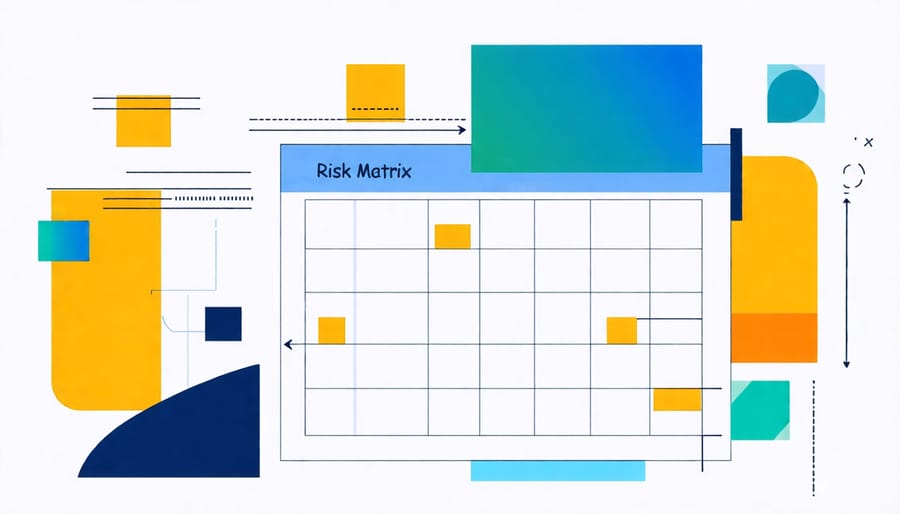Identify and assess potential risks early in the project lifecycle through comprehensive risk analysis and stakeholder input. Develop a clear risk management plan that outlines mitigation strategies, contingencies, and responsibilities for each identified risk. Implement regular risk monitoring and reporting processes to track the effectiveness of mitigation efforts and adapt strategies as needed. Foster a proactive, risk-aware culture within the project team through open communication, collaboration, and continuous learning from past experiences.
Identify and Prioritize Risks Early

Conducting a Risk Assessment
To conduct a thorough project risk assessment, begin by identifying potential risks across all project areas, including scope, schedule, budget, quality, and stakeholders. Engage your team in brainstorming sessions to uncover risks that may not be immediately apparent. Next, analyze each identified risk by assessing its likelihood of occurrence and potential impact on the project. Use a risk matrix to prioritize risks based on their severity. Develop a clear plan for mitigating high-priority risks, assigning specific team members to monitor and manage them. Continuously review and update your risk assessment throughout the project lifecycle, as new risks may emerge while others diminish. By proactively identifying, analyzing, and mitigating risks, construction professionals can minimize their impact on project success.

Develop a Robust Risk Response Plan
Assigning Risk Owners
Assigning risk owners is a critical step in effective project risk management. Each identified risk should be assigned to a specific individual or team responsible for monitoring and implementing the corresponding response strategy. Risk owners should have the necessary expertise, authority, and resources to manage their assigned risks effectively. By clearly defining risk ownership, project managers ensure accountability and timely action when risks materialize. This proactive approach helps maintain project progress, minimize potential impacts, and facilitate effective communication among stakeholders. Regularly reviewing and updating risk ownership throughout the project lifecycle is essential to adapt to evolving circumstances and maintain a robust risk management framework.
Regularly Monitor and Review Risks
Risk monitoring and review should be an ongoing process throughout the project lifecycle. Regular risk assessments help identify new risks, re-evaluate existing ones, and gauge the effectiveness of mitigation measures. Project managers should establish a risk tracking system to record and update risk information, including probability, impact, and response plans.
Effective risk tracking involves assigning clear ownership and accountability for each risk. Conducting regular risk review meetings with the project team and stakeholders promotes collaborative risk management and ensures that risks are actively monitored and managed. Project managers should also monitor key risk indicators and triggers to proactively identify potential issues before they escalate.
As the project progresses and new information becomes available, risk response plans may need to be adjusted. Agility and adaptability are crucial in effectively managing project risks. By continually monitoring and reviewing risks, project managers can make informed decisions, optimize resource allocation, and keep the project on track for success. Embracing a proactive and iterative approach to risk management is essential in navigating the complexities of construction projects and achieving desired outcomes.
Communicate and Collaborate on Risks
Effective risk communication is crucial for successful project management in the construction industry. Open and transparent dialogue among project team members and stakeholders helps identify potential risks early, facilitates collaborative problem-solving, and ensures everyone is on the same page. Regular risk review meetings should be held to discuss emerging risks, assess their impact, and develop mitigation strategies. Utilizing project management software can streamline risk communication by providing a centralized platform for tracking risks, assigning responsibilities, and monitoring progress. Encourage team members to speak up about any concerns or potential issues they observe, fostering a culture of proactive risk management. When communicating risks to stakeholders, be clear and concise, explaining the potential impact and the steps being taken to mitigate them. Collaborative risk management involves engaging all relevant parties in the process, leveraging their expertise and perspectives to develop comprehensive risk mitigation plans. By promoting open communication and collaboration, construction professionals can effectively navigate the complex landscape of project risks and ensure successful outcomes.
Leverage Project Management Software
Leveraging project management software can significantly streamline risk tracking and mitigation processes. These tools provide a centralized platform for documenting, monitoring, and addressing potential risks throughout the project lifecycle. By using features such as risk registers, automated alerts, and collaboration tools, project teams can ensure that risks are identified early, assessed accurately, and addressed promptly. Popular project management software options for the construction industry include Procore, PlanGrid, and Autodesk BIM 360. These tools integrate seamlessly with other construction management functions, enabling proactive risk management and facilitating communication among project stakeholders. By leveraging the power of project management software, construction professionals can effectively mitigate risks, minimize delays, and ensure successful project outcomes. Investing in the right software solution can provide a competitive edge and help construction firms navigate the complexities of modern projects with greater confidence and efficiency.
Conclusion
In conclusion, effective risk mitigation strategies are vital for the success of any construction project. By proactively identifying, assessing, and addressing potential risks, project managers can minimize their impact on project objectives. Key strategies include thorough risk assessment, developing contingency plans, maintaining clear communication, and fostering a risk-aware culture within the project team. Regularly monitoring and reviewing risks throughout the project lifecycle is also crucial. By embracing these proactive risk management approaches, construction professionals can enhance project resilience, prevent costly delays, and ultimately deliver successful outcomes for all stakeholders involved. Remember, in the dynamic world of construction, being prepared for the unexpected is not just an option—it’s a necessity.

